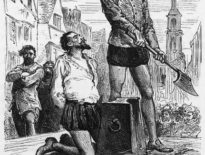In last week's Claire Chats talk, I looked at executions and the way that they were stage-managed and how victims stuck to a set format for their execution speeches and wanted to make a good end.
In today's Claire Chats, I look at why executions were public and how they ended up being entertainment for the people. Last week's chat can be viewed here.
Sources and further reading
- Staging Executions: The Theater of Punishment in Early Modern England, Sarah N. Redmond, Florida State University 2007.
- https://www.history.co.uk/history-of-america/marble-arch-and-public-executions
- http://www.capitalpunishmentuk.org/hangedt.html
- Broadside Ballads Online - http://ballads.bodleian.ox.ac.uk/ and http://ballads.bodleian.ox.ac.uk/search/themes/Executions
- Performing at the Block: Scripting Early Modern Executions, Jennifer Lillian Lodine-Chaffey, The University of Montana 2013
- Gallows Drama: Public Execution, Crowds, and Victorian Theater, SUSAN SCHUYLER, Nineteenth Century Studies
Vol. 22 (2008), pp. 15-29. - Civilizing Punishment: The End of the Public Execution in England, Randall McGowen, Journal of British Studies
Vol. 33, No. 3 (Jul., 1994), pp. 257-282 (26 pages).



Thank you good talk. I still can’t get over there demour if I was Anne Boleyn or one of the men I would have been scream my innocence and call Henry all the names under the sun.